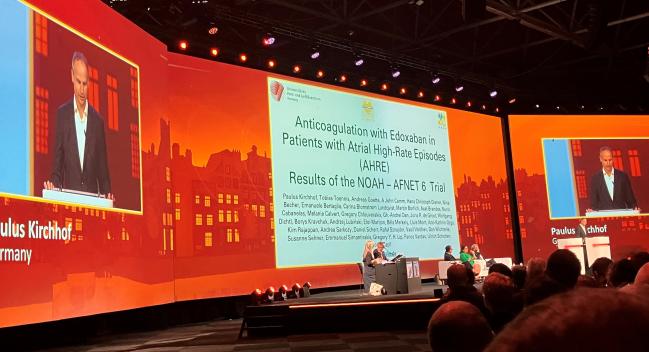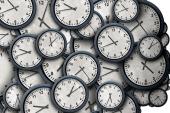NOAH-AFNET 6: Edoxaban for Atrial High-Rate Episodes: No Help, Some Harm
The randomized trial results indicate that these device-detected events should not be treated broadly with anticoagulation.

AMSTERDAM, the Netherlands—Patients with atrial high-rate episodes (AHREs) detected by implanted cardiac devices but no diagnosed atrial fibrillation (AF), fare worse when given a direct oral anticoagulant (DOAC), the placebo-controlled NOAH-AFNET 6 trial shows.
Edoxaban (Savaysa; Daiichi Sankyo) did not reduce a composite of cardiovascular death, stroke, or systemic embolism, and that lack of benefit was accompanied by a significantly greater risk of all-cause death or major bleeding (5.9% vs 4.5% per patient-year), Paulus Kirchhof, MD (University Heart and Vascular Center Hamburg, University Medical Center Hamburg–Eppendorf, Germany), reported here at the European Society of Cardiology (ESC) Congress 2023.
The findings, published simultaneously online in the New England Journal of Medicine, should come as a relief to patients, he said at a press conference: “Based on the results of our trial, patients with atrial high-rate episodes do not need to take blood thinners to prevent strokes.”
And though this is a negative trial, it provides practice-changing information since many physicians have been treating these patients with anticoagulation, Kirchhof said. “I think this trial demonstrates that anticoagulation should not be used in patients with atrial high-rate episodes until atrial fibrillation is documented by ECG.”
Speaking with TCTMD, Elena Arbelo, MD, PhD (Hospital Clínic de Barcelona – Universitat de Barcelona, Spain), the discussant following Kirchhof’s presentation, said, “It was kind of disappointing to have a negative result to this study,” but “not totally unexpected.”
Evidence available before NOAH-AFNET 6, she noted, had suggested that there was not a straightforward relationship between AHREs and the occurrence of stroke. In addition, although patients with AHREs have a higher stroke risk compared with the general population, the risk remains lower than that associated with AF.
“We were hoping that this would give us an answer to a gap in knowledge that we had for many years, what to do with these patients,” Arbelo said.
The NOAH-AFNET 6 Trial
AHREs are found in about one-fifth of patients with implanted devices, including pacemakers, defibrillators, cardiac resynchronization therapy devices, and loop recorders, Kirchhof said. Due to electrical similarities between AHREs and AF, and the proven benefits of blood thinners in patients with AF, many clinicians prescribe oral anticoagulation in select patients with AHRE, although that approach hasn’t been proven to be beneficial.
NOAH-AFNET 6, conducted at 206 sites across 18 European countries, was designed to address that question. Investigators enrolled patients 65 or older who had AHREs with an atrial rate of at least 170 bpm and a duration of at least 6 minutes, had at least one additional risk factor for stroke, and had no AF on ECG.
Patients were randomized to edoxaban at the dose approved for prevention of stroke in AF (60 mg once daily), with a half dose used for those meeting established criteria for dose reduction. In the placebo group, aspirin was given to patients who had an established indication, including peripheral or coronary artery disease and/or a history of MI or stroke; slightly more than half (53.9%) received aspirin.
The trial was stopped early due to safety concerns and an assessment of futility after a median follow-up of 21 months, although the planned enrollment had been reached. The main analysis included 2,536 patients (mean age 78; 37.4% women), who had a median CHA2DS2-VASc score of 4, indicating that they would be considered a high-risk population if they had AF, Kirchhof said. Nearly all patients (97.1%) had AHREs with an atrial rate > 200 bpm; the median AHRE duration was 2.8 hours.
The primary efficacy outcome was a composite of CV death, stroke, or systemic embolism, and there was no significant difference between the edoxaban and placebo groups (3.2% vs 4.0% per patient-year; HR 0.81; 95% CI 0.60-1.08).
The ischemic stroke rate was surprisingly low, at about 1% in each group, Kirchhof reported. There were no significant differences between trial arms in the composite of ischemic stroke or systemic embolism (1.0% vs 1.5% per patient-year; HR 0.65; 95% CI 0.39-1.07) or CV death (2.0% vs 2.2%; HR 0.90; 95% CI 0.62-1.31).
The safety outcome incorporating all-cause death and ISTH major bleeding occurred more frequently in the edoxaban arm (HR 1.31; 95% CI 1.02-1.67), driven mostly by a significant increase in major bleeding (2.1% vs 1.0%; HR 2.10; 95% CI 1.30-3.38), which, Kirchhof noted, is expected with oral anticoagulation.
In terms of other outcomes, the mean score on the EuroQol Group 5-Dimension 5-Level questionnaire (EQ-5D-5L) worsened to a similar degree in both groups. Other patient-reported outcomes, cognitive function, and functional status were unchanged during the study, with no differences between groups.
Impact on Guidelines?
As for whether the trial results are practice-changing, as Kirchhof suggested, Arbelo said “we should be more cautious” about using anticoagulation in patients with AHREs.
But there are some limitations of the trial, she said, pointing to a reduction in statistical power due to the sample size being adjusted down and the lower-than-expected stroke rates. In addition, ECGs were taken every 6 months, which may not have been frequent enough to catch all patients who developed AF during the trial.
Thus, the findings may not be enough to change practice guidelines. The AF guidelines from the ESC, for instance, note that it’s not clear whether AHRE and subclinical AF should be treated the same way as clinical AF, and they recommend performing a complete cardiovascular evaluation that includes an ECG and continuing to monitor patients for progression to clinical AF, to keep an eye on AHRE burden, and to detect changes in underlying conditions.
The guideline authors say “the use of oral anticoagulation may be considered in selected patients with longer durations of AHRE/subclinical AF (≥ 24 h) and an estimated high individual risk of stroke, accounting for the anticipated net clinical benefit and informed patient’s preferences.”
We need better methods to identify those patients with atrial high-rate episodes who are at sufficiently high risk of stroke to justify anticoagulation. Paulus Kirchhof
According to Arbelo, “I don’t think [NOAH-AFNET 6] can say the opposite,” and support a recommendation stating that no patient with an AHRE can benefit from anticoagulation. “I think they will leave the question open and decisions will probably need to be individualized and guidelines will remain the same. You will need to follow up these patients closely, particularly if you have a long-term duration of these atrial high-rate episodes, in order to detect AF and then treat it according to the clinical AF pathway.”
For Kirchhof, the results support additional randomized trials to evaluate the impact of anticoagulation in patients with rare atrial arrhythmias that resemble AF detected on consumer wearable devices.
And further research is needed to determine whether there are subsets of patients with AHREs in whom the risk-benefit balance is more favorable, he said. “That is, I think, really where we have to go as a research community: we need better methods to identify those patients with atrial high-rate episodes who are at sufficiently high risk of stroke to justify anticoagulation.”
Of note, the NOAH-AFNET 6 results were consistent across various subgroups defined by AHRE duration, level of CHA2DS2-VASc risk, and indication for aspirin.
Todd Neale is the Associate News Editor for TCTMD and a Senior Medical Journalist. He got his start in journalism at …
Read Full BioSources
Kirchhof P, Toennis T, Goette A, et al. Anticoagulation with edoxaban in patients with atrial high-rate episodes. N Engl J Med. 2023;Epub ahead of print.
Disclosures
- The trial was supported by the German Ministry of Education and Research through the German Center for Cardiovascular Research (DZHK) and by Daiichi Sankyo Europe, with further support provided by the European Union (EU) through the Characterizing Atrial Fibrillation by Translating Its Causes into Health Modifiers in the Elderly (CATCH ME) project, the AFFECT-EU consortium, and the MAESTRIA consortium; the British Heart Foundation; the German Research Foundation; DZHK; and the Leducq Foundation.
- Daiichi Sankyo Europe provided the doses of edoxaban and placebo for the trial.
- Kirchhof reports being speaker of the board for AFNET; receiving grants/contracts to AFNET from Daiichi Sankyo Europe GmbH; serving as a nonvoting board member for the European Society of Cardiology; receiving grants/contracts to AFNET from multiple public funders and drug/device companies; and being listed as inventor on two patents related to AF diagnosis and therapy held by the University of Hamburg.





Comments